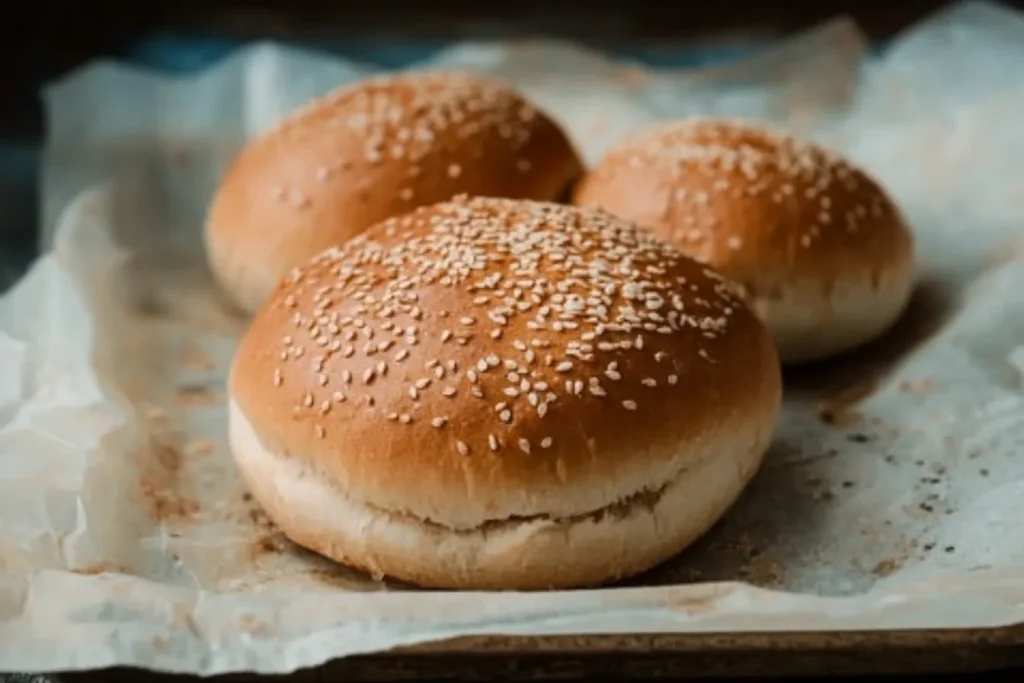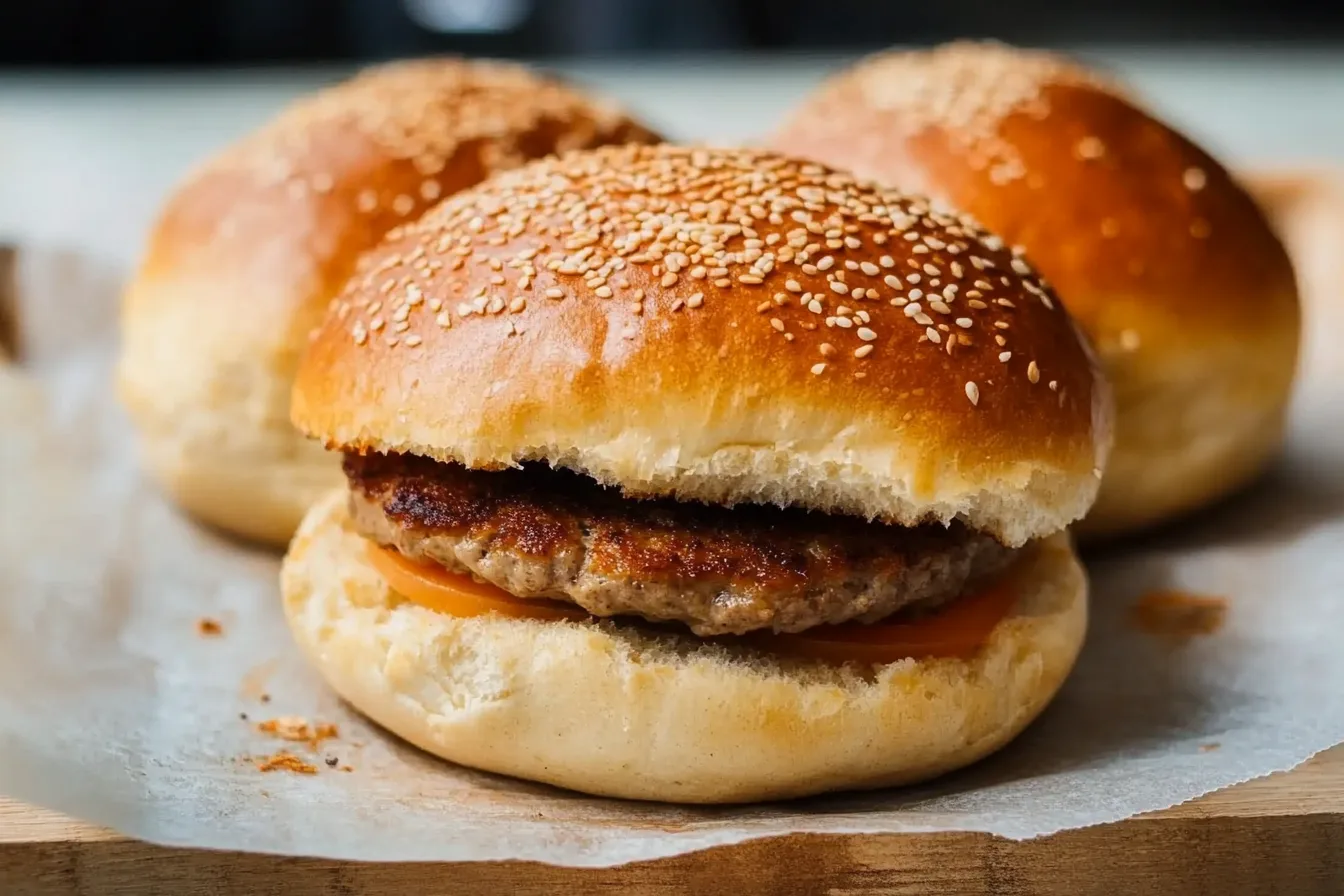Burgers are only as good as the buns that hold them. Sourdough hamburger bun recipe elevates the classic burger experience with their rich flavor, tender crumb, and artisanal touch. Whether you’re crafting gourmet burgers for a weekend barbecue or simply upgrading a sandwich, these buns are sure to impress.

Introduction to Sourdough Hamburger Bun Recipe
What Makes Sourdough Buns Special?
Sourdough buns stand out for their:
- Unique Flavor: The tangy notes of the sourdough starter add depth that complements savory fillings.
- Texture: They’re soft yet sturdy, holding up to even the juiciest burgers without falling apart.
- Artisanal Appeal: With their golden crust and homemade touch, sourdough buns bring elegance to any meal.
Health Benefits of Sourdough Hamburger Bun Recipe
Sourdough is celebrated not only for its taste but also its health benefits:
- Digestibility: The fermentation process breaks down gluten, making it easier on the stomach.
- Nutrient Absorption: Fermented bread enhances the bioavailability of minerals like zinc and magnesium.
- Natural Preservatives: Sourdough’s natural acidity keeps it fresh longer without additives.
Pro Tip: Incorporating whole grains into the dough can further boost the nutritional profile.
Perfect Pairings: Why Sourdough Buns Elevate Any Burger
Sourdough buns enhance the flavors of:
- Classic Cheeseburgers: The tangy notes balance the richness of cheese.
- Plant-Based Patties: Add complexity to vegan or vegetarian fillings.
- Creative Toppings: Whether you’re adding pickled onions or spicy aioli, sourdough’s subtle acidity complements bold flavors.
Ingredients for Sourdough Hamburger Bun Recipe
Key Components of the Dough
Sourdough Starter: Active and Well-Fed
- Use a bubbly, recently fed starter for the best rise and flavor.
- Pro Tip: Feed your starter 4-6 hours before beginning the recipe.
Flour: Bread Flour for Strength or All-Purpose Flour
- Bread Flour: Creates a sturdy bun with a chewy texture.
- All-Purpose Flour: Yields a softer bun that’s still structured.
Liquids: Milk, Water, or Plant-Based Alternatives
- Milk: Adds richness and a tender crumb.
- Plant-Based Alternatives: Almond or oat milk work well for dairy-free versions.
Sweeteners: Sugar, Honey, or Maple Syrup
- Add a touch of sweetness to balance the sourdough tang.
- Honey or Maple Syrup: Infuse subtle, natural flavors into the dough.
Fats: Butter, Olive Oil, or Coconut Oil
- Butter: Classic choice for soft, flavorful buns.
- Olive Oil: Adds moisture and a hint of fruitiness.
Pro Tip: Use unsalted butter or adjust the salt in the recipe accordingly.
Optional Ingredients for Flavor Enhancements
Herbs or Spices: Garlic Powder, Rosemary, or Sesame Seeds
- Infuse the dough with minced herbs for a savory twist.
Toppings: Egg Wash, Seeds, or Grated Cheese
- Apply an egg wash before baking for a shiny, golden crust.
- Sprinkle with sesame seeds, poppy seeds, or grated cheese for added flair.
Pro Tip: Use flaky sea salt as a topping for a burst of flavor.
Tools and Equipment Needed
Essentials for Baking Sourdough Hamburger Bun Recipe
Mixing Bowls, Bench Scraper, and Measuring Tools
- Mixing Bowls: For combining and fermenting the dough.
- Bench Scraper: Useful for dividing and shaping the dough.
Stand Mixer with Dough Hook Attachment (Optional)
- Makes kneading faster and more consistent but isn’t required for great results.
Baking Sheet or Cast-Iron Pan
- Baking Sheet: Ideal for evenly baked buns.
- Cast-Iron Pan: Provides extra heat retention and browning.
Specialty Tools for Perfect Buns
Kitchen Scale for Precision
- Measure ingredients by weight for accuracy and consistency.
Proofing Basket or Dough Cutter for Shaping
- Proofing baskets help maintain the dough’s shape during its final rise.
Pro Tip: Use parchment paper to prevent sticking during baking.
Preparing the Sourdough Starter
Feeding and Activating Your Sourdough Starter
- Remove Starter: Take about ½ cup of sourdough starter from its storage container.
- Feed It: Mix equal parts (by weight) of flour and water into the starter. For example, if you have 100g of starter, add 50g of flour and 50g of water.
- Let It Rest: Allow the starter to sit at room temperature for 4-6 hours, or until it’s bubbly and has doubled in size.
Pro Tip: The starter is ready when it passes the “float test” (a spoonful floats in water).
How to Tell When Your Starter Is Ready to Use
- Look for Activity: Bubbles and a slightly domed surface are signs of an active starter.
- Smell Test: The starter should have a pleasant tangy smell, not overly sour or alcoholic.
Pro Tip: If your starter isn’t rising, feed it again and let it rest for another few hours.
Making the Sourdough Bun Dough
Mixing the Ingredients for a Smooth Dough
Hydrating the Flour with Liquids and Starter
- In a large mixing bowl, combine:
- 1 cup (240g) of active sourdough starter.
- ¾ cup (180ml) of milk (or plant-based alternative).
- 2 tablespoons of sweetener (sugar, honey, or maple syrup).
- Mix well until the starter dissolves into the liquid.
Adding Sweeteners and Fats for Flavor and Texture
- Stir in 3 tablespoons of softened butter (or olive oil for a dairy-free version).
- Gradually add 3 ½ cups (420g) of flour and 1 ½ teaspoons of salt.
Pro Tip: Add the flour in increments to avoid a sticky or overly dry dough.
Kneading the Dough for Optimal Gluten Development
- Turn the dough out onto a floured surface and knead for 8-10 minutes, or until it becomes smooth and elastic.
- Alternatively, use a stand mixer with a dough hook on medium speed for 5-7 minutes.
Pro Tip: The dough should feel slightly tacky but not stick to your hands excessively.
Bulk Fermentation: Allowing the Dough to Rise
Timing and Temperature Tips for Fermentation
- Transfer the dough to a lightly oiled bowl and cover with a damp towel.
- Let it rise at room temperature for 4-6 hours, or until it doubles in size.
How to Handle Over- or Under-Fermented Dough
- Under-Fermented Dough: If the dough hasn’t risen enough, give it additional time in a warm spot.
- Over-Fermented Dough: Gently fold the dough to redistribute air bubbles and proceed with shaping.
Pro Tip: A slower, cooler fermentation (e.g., overnight in the refrigerator) enhances flavor.
Shaping and Proofing the Buns
Dividing the Dough into Even Portions
- Turn the fermented dough onto a lightly floured surface.
- Divide the dough into 8-10 equal portions using a bench scraper or knife.
Pro Tip: Use a kitchen scale to weigh each piece for uniform buns.
Shaping the Dough into Perfect Rounds
- Take each portion and form a smooth ball by tucking the edges underneath and rolling gently on the surface.
- Place the shaped buns onto a parchment-lined baking sheet, leaving space for expansion.
Pro Tip: Cover with a damp towel during shaping to prevent the dough from drying out.
Final Proofing: Achieving the Right Texture Before Baking
- Cover the buns loosely with plastic wrap or a damp cloth.
- Let them proof at room temperature for 1-2 hours, or until they’ve puffed up and feel slightly springy when pressed.
Pro Tip: Avoid over-proofing, as this can lead to flat buns during baking.
Baking the Sourdough Hamburger Bun Recipe
Preheating the Oven for Even Baking
- Preheat your oven to 375°F (190°C) for optimal browning and even cooking.
- Position the oven rack in the center for consistent heat distribution.
Pro Tip: Place a shallow pan of water on the lower rack to create steam for softer buns with a glossy crust.
Adding Toppings and Finishing Touches
Applying an Egg Wash for a Golden Crust
- Whisk together 1 egg with a tablespoon of water or milk.
- Lightly brush the tops of the proofed buns with the egg wash using a pastry brush.
Pro Tip: For a vegan alternative, use a mixture of almond milk and maple syrup.
Sprinkling with Seeds or Spices for Extra Flavor
- Add your desired toppings:
- Sesame Seeds: Classic and nutty.
- Poppy Seeds: Slightly sweet and crunchy.
- Flaky Sea Salt: Enhances the tang of sourdough.
Pro Tip: Press seeds lightly into the dough to ensure they stick during baking.
Baking Times and Temperature for Optimal Results
- Bake the buns for 20-25 minutes, or until golden brown.
- Rotate the baking sheet halfway through for even browning.
Pro Tip: Tap the bottom of a bun—if it sounds hollow, they’re done!
Cooling the Buns to Retain Moisture and Texture
- Transfer the buns to a wire rack immediately after baking.
- Let them cool for at least 20 minutes before slicing.
Pro Tip: Avoid cutting while hot, as this can cause the crumb to become gummy.
Serving Suggestions for Sourdough Buns
Pairing with Gourmet Burgers or Sandwich Fillings
- Classic Burgers: Use the buns to elevate cheeseburgers, veggie patties, or pulled pork sandwiches.
- Breakfast Sandwiches: Layer scrambled eggs, bacon, and avocado for a morning treat.
- Sliders: Make mini versions for appetizers or party platters.
Pro Tip: Toast the buns lightly for added texture and to prevent sogginess from juicy fillings.
Creative Uses: Breakfast Sandwiches or Sliders
- Breakfast Delights: Top with fried eggs, spinach, and a dollop of hollandaise sauce.
- Party Sliders: Use smaller buns for bite-sized creations like chicken or tofu sliders.
Accompaniments: Dips, Spreads, or Sides
- Dips: Pair with garlic aioli, chipotle mayo, or tzatziki.
- Sides: Serve alongside fries, roasted vegetables, or a crisp coleslaw.
Pro Tip: Spread a layer of butter or flavored mayo on the buns for an extra indulgent touch.
Storing and Freezing Sourdough Buns
Best Practices for Storing Fresh Buns
- Store cooled buns in an airtight container or resealable bag at room temperature for up to 3 days.
- For longer storage, refrigerate, but bring to room temperature before serving for the best flavor.
How to Freeze and Reheat Sourdough Buns
- Freezing: Wrap each bun tightly in plastic wrap or aluminum foil and place in a freezer bag. Freeze for up to 3 months.
- Reheating: Thaw at room temperature, then warm in the oven at 300°F (150°C) for 5-10 minutes.
Pro Tip: Slice buns in half before freezing for easier reheating.
Variations of Sourdough Hamburger Buns
Whole Wheat or Multigrain Sourdough Buns
- Replace half the bread flour with whole wheat or multigrain flour for a nuttier flavor and added fiber.
- Increase hydration slightly, as whole grains absorb more liquid.
Herb-Infused or Cheese-Topped Buns
- Mix dried herbs like rosemary, thyme, or oregano into the dough for an aromatic twist.
- Sprinkle shredded cheese, such as cheddar or Parmesan, on top before baking.
Pro Tip: Combine garlic powder with Parmesan for an irresistible flavor.
Gluten-Free Sourdough Buns: Adapting the Recipe
- Use a gluten-free sourdough starter and a mix of gluten-free flours (e.g., rice flour, tapioca starch, and potato starch).
- Add xanthan gum to improve structure and elasticity.
Pro Tip: Proof the buns longer for a lighter texture, as gluten-free doughs tend to be denser.
Tips for Perfect Sourdough Hamburger Buns
Monitoring Dough Consistency for Best Results
- The dough should feel soft and slightly tacky but not overly sticky.
- Adjust with small amounts of flour or liquid as needed.
Balancing Sweetness and Acidity in the Flavor
- Adjust the sweetener to taste if the sourdough flavor is too tangy.
- A touch of honey or maple syrup can offset acidity while complementing the starter’s natural flavor.
Troubleshooting Common Issues: Flat or Dense Buns
- Flat Buns: May result from over-proofing or weak starter. Ensure your starter is active and bubbly before use.
- Dense Buns: Could indicate insufficient kneading or under-proofing. Allow more time for the dough to rise.
Pro Tip: Keep an eye on the dough’s volume during proofing rather than relying solely on time.
Frequently Asked Questions (FAQs)
How Long Does It Take to Make Sourdough Buns?
The entire process, including fermentation and proofing, takes 8-12 hours. For faster results, use a warmer environment to shorten rise times.
Can I Use Store-Bought Sourdough Starter?
Yes! Store-bought starter works well, but ensure it’s active by feeding it before use.
What Are the Best Toppings for Sourdough Buns?
Popular toppings include sesame seeds, poppy seeds, grated cheese, or even a light sprinkle of everything bagel seasoning.
Conclusion: Mastering Sourdough Hamburger Buns
Recap of Steps and Techniques
Crafting sourdough hamburger buns involves:
- Preparing a bubbly, active sourdough starter.
- Mixing and kneading the dough for a smooth texture.
- Proofing, shaping, and baking to golden perfection.
Encouragement to Experiment with Flavors and Textures
Feel free to customize your buns with herbs, cheeses, or whole grains. Each variation adds a personal touch to your recipe.
Sharing Sourdough Creations with Family and Friends
Impress your loved ones with these artisanal buns, perfect for burgers, sandwiches, and more. Sourdough is more than bread—it’s an experience worth sharing.
Enjoy baking!
Let me know if you’d like additional recipes or tips to perfect your sourdough skills! 😊

Sourdough Hamburger Bun Recipe
Equipment
- Mixing bowl
- Stand mixer (optional)
- Baking Sheet
- Parchment Paper
- Pastry brush
Ingredients
Main Ingredients
- 1/2 cup sourdough starter active and bubbly
- 3 cups all-purpose flour plus more for dusting
- 1/2 cup warm milk around 110°F
- 1 large egg room temperature
- 2 tablespoons unsalted butter softened
- 2 tablespoons granulated sugar
- 1 teaspoon salt
For Topping
- 1 egg beaten for egg wash
- 2 tablespoons sesame seeds optional
Instructions
- In a mixing bowl, combine the sourdough starter, warm milk, egg, sugar, and softened butter. Mix until combined.
- Add the flour and salt. Mix until a dough forms, then knead for 8-10 minutes by hand or 5 minutes using a stand mixer fitted with a dough hook.
- Cover the dough with a damp cloth and let it rise in a warm place for 4-6 hours, or until doubled in size.
- Once risen, divide the dough into 8 equal portions. Shape each portion into a ball and place on a parchment-lined baking sheet, leaving space between them.
- Cover the shaped buns with a cloth and let them rise for another 1-2 hours until puffy.
- Preheat your oven to 375°F (190°C). Brush the tops of the buns with beaten egg and sprinkle with sesame seeds if desired.
- Bake for 18-20 minutes, or until golden brown. Cool on a wire rack before slicing. Enjoy!
